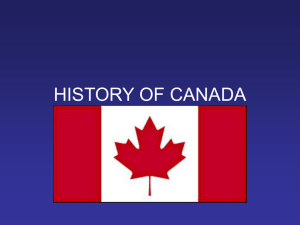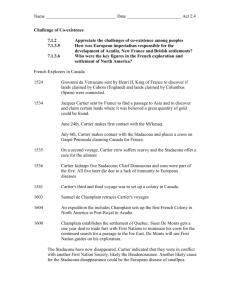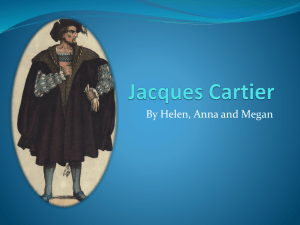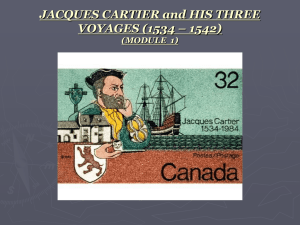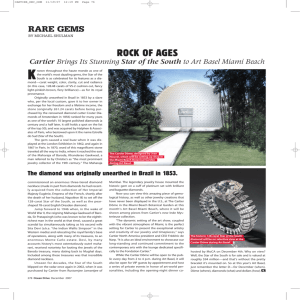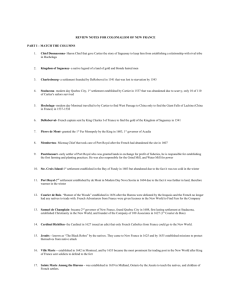The Rise and Fall of New France
advertisement
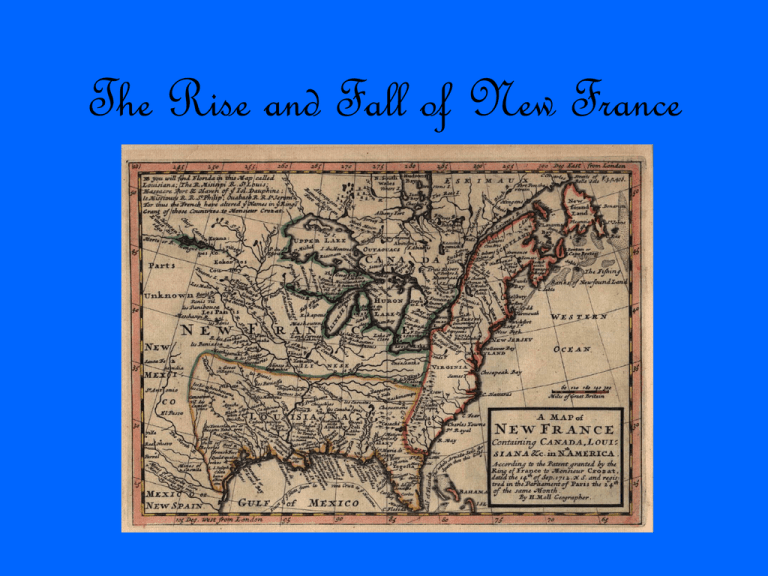
The Rise and Fall of New France In the beginning • Before the arrival of the Europeans, the land we call North America was home to hundreds of First Nations, with distinct languages and cultures. The Vikings • The first Europeans to arrive in North America were the Vikings, around 1000 C.E. • They came from Scandinavia (Sweden, Norway and Denmark) and established a small settlement at L’Anse aux Meadows, Newfoundland, which they called “Vinland”. • The settlement failed, since there were too few settlers, and they fought with the Beothuk, who drove them off. Vinland and Leif Erikson John Cabot • Giovanni Caboto, an Italian navigator also known as John Cabot, claimed “New Found Land” for Henry VII of England in 1497. • He also discovered great schools of cod fish off the coast of Grand Banks. French Exploration • In 1524, France sent Giovanni Verrazano to find the Northwest Passage to Asia. • He discovered that North America was not an archipelago of islands, but a continent. Jacques Cartier • In 1534, France sent Jacques Cartier to find the Northwest Passage. • He reached the Gaspé Peninsula, which he claimed for France. • He also kidnapped two Iroquoians, Taignoagny and Domagaya, and brought them back to France to learn French so that they could guide him when they returned. Cartier’s Second Voyage • The next year, Cartier arrived in “Canada”, an Iroquoian word meaning village that Cartier thought was the name of the area around the St. Lawrence. • He explored the St. Lawrence River, visiting Stadacona and Hochelaga. • The rapids west of Hochelaga, which he named “La Chine” (China), prevented him from travelling further. Cartier fails • Cartier’s men spent the winter at Stadacona, where 25 men died of scurvy. • Donnacona, the chief of Stadacona, showed Cartier how to make Vitamin C-rich tea from spruce bark and needles, saving many lives. • To thank him, Cartier kidnapped Donnacona and took him to France, where Donnacona died. • As a result, the Iroquois refused to trade with the French, and Cartier’s colony failed. • The French would not try to settle in North America for another sixty years. Early French settlements • In 1600, Pierre de Chauvin and François Gravé established a French fur trading post at Tadoussac. • In 1603, Pierre Du Gua de Monts founded a settlement at Port Royal (present day Nova Scotia). Samuel de Champlain • The settlement failed in 1607 when de Monts lost his royal fur trading license. • In 1608, de Monts’ assistant, Samuel de Champlain, founded a colony in Quebec City. Alliances with First Nations • Champlain made alliances with the Algonquins and Montagnais that lived near Quebec, as well as with the Wendat, whom the French called “Hurons”, and who controlled most of the territory around the Great Lakes. • Champlain sent “coureurs de bois” like Étienne Brulé to live with the Wendat, trade with them, marry their women and explore their territory. • In addition to the coureurs de bois, the French also sent Jesuit missionaries to live with the Hurons. • The Hurons did not want the missionaries, but the French made this a condition of trading. Huron-Iroquois Wars • Exposure to European diseases such as measles and smallpox reduced the Hurons’ population from 40,000 to 12,000 between 1634-1640. • The Hurons were further weakened by divisions between Christian and non-Christian Hurons, and addiction to alcohol introduced by French traders. • In wars over fur trading territories, the Hurons were easily defeated by the Iroquois, who were armed with muskets acquired from their Dutch allies. • Surviving Hurons abandoned their territory and relocated to Wendake, near Quebec City. Colonization of New France • In 1627, control of New France was given to the Company of a Hundred Associates. • The company set up seigneuries along the St. Lawrence River, feudal-style manors given to settlers. • Peasant farmers who lived on the seigneuries were known as “habitants”. • Montréal was founded in 1642 by the Société de Notre-Dame de Montréal, as a Catholic mission originally known as Ville-Marie. A Royal Colony • In 1660, the company lost its trading monopoly, and New France became a royal colony. • The first administrator was Jean Talon. • He brought hundred of young women, known as “filles du roi” from France to marry the mostly male settlers. Continued Exploration • The French continued to explore the North American interior: in the 1650s Pierre Radisson and Médart de Groseilliers explored the Western Great Lakes. Along the Mississippi • In the 1670s traders such as Louis Jolliet and Jacques Marquette began exploring the territory along the Ohio, Illinois and Mississippi rivers. • René Robert Cavalier de la Salle was the first European to reach the mouth of the Mississippi River in the Gulf of Mexico in 1782. The Great Peace of Montreal • For most of the seventeenth century, New France was at war with the Five Nations Confederacy of the Iroquois. • The Five Nations were the most powerful First Nations in the St. Lawrence/Great Lakes region, and were allied with the Dutch and later the English. • In the 1670s and 1680s the French negotiated treaties with the Five Nations’ enemies to the west, such as the Miami and the Illinois. • In 1701, over 1300 delegates representing 40 nations, including the Five Nations and the French, signed a peace treaty in Montreal. French-English Wars • The French and English fought four wars in North America. • From 1689-1697, King William’s War was fought between the French, English and their First Nation allies in Canada, Acadia and New England. • From 1704-1713 the French and their Spanish allies in Florida fought against the British in a war from Newfoundland to Florida. • In 1713, the Treaty of Utrecht gave the British control of Acadia. The Expulsion of the Acadians • After the British conquered Acadia in 1713, the Acadians refused to sign an oath of loyalty to Britain, but they promised to remain neutral in the event of war. • In 1755, following the outbreak of the Seven Years War, the British decided to expel the Acadians. Le Grand Dérangement • 11,500 Acadians were deported (3/4 of the Acadian population of Nova Scotia), and one-third died at sea. • The rest settled in the Thirteen Colonies, France and England, and many eventually made their way to Louisiana, where they became known as “Cajuns”. The Seven Years War • King George’s War: fought between Britain and France, 1744-1748. • In 1755, the Seven Years War began as a result of conflict over the Ohio Valley. • In 1758, the British under Gen. Wolfe captured the fortress of Louisbourg, which allowed British ships to enter the Gulf of St. Lawrence. The Conquest of New France • In 1760, the British and French armies met on the Plains of Abraham. • Both Wolfe and the French General Montcalm were killed in the battle. • The British won, and Quebec surrendered. • Montréal was captured the same year. • The Treaty of Paris in 1763 declared New France to be a British possession. The Plains of Abraham by George Campion

